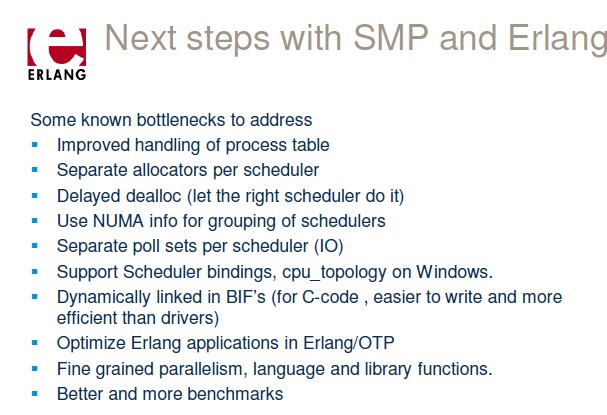Erlang R15的内存delay dealloc特性对消息密集型程序的影响
那么对于多线程的程序来讲,这个硬件的变化对软件也有很大的影响。在多线程程序里面,通常一个线程会为一个对象分配内存,然后把这个对象传递到不同的线程去使用,最后由其他线程释放内存。而这二个线程可能在不同的CPU上运行,这个场景很普遍,比如说Erlang的消息机制。如果谁创建谁释放对象,那么对于消息密集型程序会有很多帮助。
R15的最大的运行期优化见: https://github.com/erlang/otp/commit/a67e91e658bdbba24fcc3c79b06fdf10ff830bc9
这个特性也就是之前声称的delay dealloc特性
目前规划里面的1,2,3,4在R15里面都已经实现了。
Optimize memory allocation
A number of memory allocation optimizations have been implemented. Most
optimizations reduce contention caused by synchronization between
threads during allocation and deallocation of memory. Most notably:
* Synchronization of memory management in scheduler specific allocator
instances has been rewritten to use lock-free synchronization.
* Synchronization of memory management in scheduler specific
pre-allocators has been rewritten to use lock-free synchronization.
* The ‘mseg_alloc’ memory segment allocator now use scheduler specific
instances instead of one instance. Apart from reducing contention
this also ensures that memory allocators always create memory
segments on the local NUMA node on a NUMA system.
我们来尝鲜演示下,首先找个消息密集型的程序: 消息由一种线程组成ring传送。
$ cat threadring.erl
%%% The Computer Language Benchmarks Game
%%% http://shootout.alioth.debian.org/
%%% Contributed by Jiri Isa
%%% optimized run time options by shun shino
-module(threadring).
-export([main/1, roundtrip/2]).
-define(RING, 503).
start(Token) ->
H = lists:foldl(
fun(Id, Pid) -> spawn(threadring, roundtrip, [Id, Pid]) end,
self(),
lists:seq(?RING, 2, -1)),
H ! Token,
roundtrip(1, H).
roundtrip(Id, Pid) ->
receive
1 ->
io:fwrite("~b~n", [Id]),
erlang:halt();
Token ->
Pid ! Token - 1,
roundtrip(Id, Pid)
end.
main([Arg]) ->
Token = list_to_integer(Arg),
start(Token).
$ erlc threadring.erl
$ time erl -smp disable -noshell -run +t 8192 +ec +K true +P 1000 +hmbs 1 +hms 4 +sss 4 threadring main 500000000
396
real 1m46.900s
user 0m35.010s
sys 1m11.870s
$ time otp/bin/erl -smp disable -noshell -run +t 8192 +ec +K true +P 1000 +hmbs 1 +hms 4 +sss 4 threadring main 500000000
396
real 1m37.884s
user 0m5.350s
sys 1m32.513s
我们可以看到简单的对比,性能大概有8%的提升。在复杂的程序里面性能应该提升更大。
祝玩得开心。
建议继续学习:
- whatsapp深度使用Erlang有感 (阅读:5295)
- Erlang match_spec引擎介绍和应用 (阅读:5208)
- php-erlang (阅读:4889)
- gen_tcp调用进程收到{empty_out_q, Port}消息奇怪行为分析 (阅读:3950)
- hibernate使用注意事项 (阅读:3853)
- Erlang如何限制节点对集群的访问之net_kernel:allow (阅读:3598)
- Erlang linkin driver用port_control方式时的一些经验分享 (阅读:3538)
- ERLANG OTP源码分析 – gen_server (阅读:3268)
- erlang学习手记 (阅读:3247)
- gen_tcp容易误用的一点解释 (阅读:3096)
扫一扫订阅我的微信号:IT技术博客大学习
- 作者:Yu Feng 来源: Erlang非业余研究
- 标签: dealloc Erlang
- 发布时间:2011-11-24 00:01:55
-
 [869] WordPress插件开发 -- 在插件使用
[869] WordPress插件开发 -- 在插件使用 -
 [136] 解决 nginx 反向代理网页首尾出现神秘字
[136] 解决 nginx 反向代理网页首尾出现神秘字 -
 [57] 整理了一份招PHP高级工程师的面试题
[57] 整理了一份招PHP高级工程师的面试题 -
 [56] 分享一个JQUERY颜色选择插件
[56] 分享一个JQUERY颜色选择插件 -
 [54] 用 Jquery 模拟 select
[54] 用 Jquery 模拟 select -
 [54] 如何保证一个程序在单台服务器上只有唯一实例(
[54] 如何保证一个程序在单台服务器上只有唯一实例( -
 [54] CloudSMS:免费匿名的云短信
[54] CloudSMS:免费匿名的云短信 -
 [53] Innodb分表太多或者表分区太多,会导致内
[53] Innodb分表太多或者表分区太多,会导致内 -
 [53] 全站换域名时利用nginx和javascri
[53] 全站换域名时利用nginx和javascri -
 [51] jQuery性能优化指南
[51] jQuery性能优化指南

